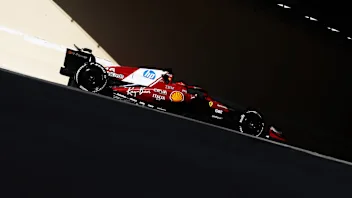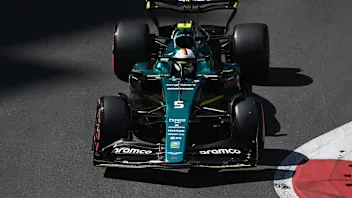As the eyes of the world turn to Australia next weekend for the start of the 2014 FIA World Championship there is one vital ingredient that was missing from the final races of 2013: uncertainty.
Everything has gone back into the melting pot after the biggest set of rule changes in the sport’s history, and after 12 days of winter testing - four in Spain and eight in Bahrain - the reality is that nobody really knows what to expect when the lights go out in Albert Park on Sunday, March 16.
On paper, Mercedes and Williams dominated the testing, chased by Ferrari and Force India, while four-time champions Red Bull endured a disastrous campaign which leaves them wondering if they can even finish the first race, let alone dominate it the way that Sebastian Vettel did so often in the final season of the 2.4-litre normally aspirated V8 formula.
Formula One racing has had big rule changes in the past, of course, such as the doubling of engine capacity from 1.5 litres to 3 litres back in 1966. But there have never been so many significant changes in one go. And it’s not just aerodynamics and engine capacity. The entire powertrain is new as the sport pushes the boundaries of hybrid technology, a move that is certain to benefit road car design and means that 2014’s F1 machines will run races on 35 percent less fuel than last season.
The change in engine design philosophy is the most profound aspect of the new formula, and will help to make the powertrain a performance differentiator just as the aerodynamics are. Teams must master the nuances of the supremely complex technology, not least how to manage the balance between mechanical power and the electrical system with its Energy Recovery Systems (ERS) and the associated batteries, which will affect both horsepower and fuel economy and thus significantly affect the face of race strategy.
The normally aspirated 90-degree 2.4-litre 18,000 rpm V8s were relatively uncomplicated, even with their KERS. But the new 90-degree 1.6-litre 15,000 rpm V6s are far more complex. The turbocharger reappears for the first time since 1988, but there are also two forms of energy harvesting, using two separate Motor Generator Units (MGU), which convert mechanical and heat energy to electrical energy and vice versa.
The MGU-K works like an uprated version of KERS, converting kinetic energy generated under braking into electricity (rather than it escaping as heat). It also acts as a motor under acceleration, returning power to the drivetrain from the Energy Store (ES). The MGU-H, meanwhile, is connected to the turbocharger and converts heat energy from exhaust gases into electrical energy. The energy can then be used to power the MGU-K (and thus the drivetrain) or be retained in the ES for subsequent use. The MGU-H also controls the speed of the turbo, speeding it up (to prevent turbo lag) or slowing it down in place of a more traditional wastegate.
The basic engine produces around 447 kW (600 bhp), but compared to 2013 KERS, the new ERS has twice the power (120 kW [160 bhp] as opposed to 60 kW [80 bhp]) for 33s a lap. That’s twice as much power for nearly five times longer than the V8’s system and a performance effect around 10 times greater. Thus the V6s, turbocharged at 3.4 bar (50 psi) will develop similar power overall to the V8s, 567 kW (760 bhp). And there will be far more torque - 425 Nm (570 lb ft) at 10,500 rpm even without the energy recovery systems, as opposed to 300 Nm (402 lb ft) at 17,500 rpm last year. The new energy systems deploy automatically according to the chosen mapping, rather than needing to be selected by the driver, and electronic fly-by-wire rear braking is allowed to cope with the altered characteristics of the brake energy harvesting.
Additionally, the teams are only allowed 100 kg (140 litres) of fuel, flowed at the rate of 100 kg/hour by FIA-mandated fuel regulators, as opposed to the 2.4s’ 160 kg or so (225 litres) flowed at around 170 kg/hour. Part of the greater efficiency is down to the use for the first time in F1 racing of Direct Injection (DI), where fuel is injected directly into the combustion chamber so that the fuel-air mixture is formed within the cylinder. The precision of this process critically influences power delivery and fuel efficiency.
Just to spice things up further, drivers are allowed only five power units per season rather than the eight in previous years, and the specification was frozen for the year by the FIA in Bahrain on February 28.
In the transmission part of the powertrain, cars now have eight rather than seven speeds, with gear ratios required by the FIA to be homologated for the season.
So that’s the powertrain rule changes. What about the aerodynamics?
The biggest change is to the exhaust. A single exhaust pipe is mandated with fixed dimensions and angle of protrusion. This means teams will no longer be able to generate downforce by directing exhaust gases to the rear diffuser.
The tip of the nose must be centred at 185 mm, which is just above the front wing, which is why there are so many unusual looking noses, and the effect not only improves safety but also compromises airflow beneath the nose and the chassis, a crucial area.
The front wing is 150 mm narrower, and while that might not seem much it places the endplates right in front of, rather than flush with, the outer edge of the front tyres. That has had a significant effect on airflow and efficiency. The rear wing is smaller, with a ban on horizontal mounting beams, but DRS remains. To compensate for the lost downforce its gap now opens up to 65 mm rather than 50 to help to reduce drag further. The minimum weight has also increased significantly, from 642 kg to 691 kg.
The new breed of cars is trickier to drive, with the reduced downforce and much greater torque generating oversteer. And though engine maps will be decided before a race, fuel conservation via careful use of the throttle will still be a key in race strategy.
The drivers will also, of course, still have to manage their tyres, particularly the rears with the extra torque. Pirelli say their 2014 rubber is more durable and creates fewer ‘marbles’, and the plan is to use compounds only one step apart at each race rather than two as last year. For Australia, they will supply their medium and soft compounds, and believe they will generate two or even three pit stops.
After initial fears that the new cars might be slow, the speeds achieved in Bahrain compared well with last year’s at the Sakhir circuit. Felipe Massa ended testing with the fastest time overall of 1m 33.258s, whereas Nico Rosberg’s pole time for the 2013 race was 1m 32.330s.
All of the new rules are complemented by changes on the driver front. At McLaren the super-exciting Kevin Magnussen heads the rookies, while Daniil Kvyat steps in at Toro Rosso and Marcus Ericsson at Caterham, where Kamui Kobayashi makes a welcome return. Kimi Raikkonen switches back to Ferrari, Felipe Massa to Williams, Daniel Ricciardo to Red Bull, Nico Hulkenberg and Sergio Perez to Force India, Adrian Sutil to Sauber and Pastor Maldonado to Lotus.
And F1 racing is set to return to Austria and to venture to Russia for the first time, adding to its global appeal.
Will Mercedes dominate in Australia? Can Williams challenge for victory? What about Ferrari? And do Red Bull have the faintest chance?
There are so many questions that can only be answered on the track and that, allied to the prospect of some significant unreliability, makes the first race of the new era the most open in recent history.
Continued in Part Two
Next Up
Related Articles
 EXPLAINED: The key terms for F1’s new-for-2026 rules
EXPLAINED: The key terms for F1’s new-for-2026 rules Verstappen confirms new number for 2026 season
Verstappen confirms new number for 2026 season F1 CEO Domenicali reflects on 'phenomenal' 2025
F1 CEO Domenicali reflects on 'phenomenal' 2025 Ferrari confirm launch date for 2026 campaign
Ferrari confirm launch date for 2026 campaign 11 times F1 drivers took another driver’s car number
11 times F1 drivers took another driver’s car number ExclusiveHow Norris made his school teachers ‘enormously proud’
ExclusiveHow Norris made his school teachers ‘enormously proud’